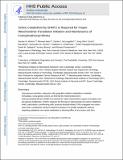Serine Catabolism by SHMT2 Is Required for Proper Mitochondrial Translation Initiation and Maintenance of Formylmethionyl-tRNAs
Author(s)
Sabatini, David M.
DownloadAccepted version (1.875Mb)
Publisher with Creative Commons License
Publisher with Creative Commons License
Creative Commons Attribution
Terms of use
Metadata
Show full item recordAbstract
Upon glucose restriction, eukaryotic cells upregulate oxidative metabolism to maintain homeostasis. Using genetic screens, we find that the mitochondrial serine hydroxymethyltransferase (SHMT2) is required for robust mitochondrial oxygen consumption and low glucose proliferation. SHMT2 catalyzes the first step in mitochondrial one-carbon metabolism, which, particularly in proliferating cells, produces tetrahydrofolate (THF)-conjugated one-carbon units used in cytoplasmic reactions despite the presence of a parallel cytoplasmic pathway. Impairing cytoplasmic one-carbon metabolism or blocking efflux of one-carbon units from mitochondria does not phenocopy SHMT2 loss, indicating that a mitochondrial THF cofactor is responsible for the observed phenotype. The enzyme MTFMT utilizes one such cofactor, 10-formyl THF, producing formylmethionyl-tRNAs, specialized initiator tRNAs necessary for proper translation of mitochondrially encoded proteins. Accordingly, SHMT2 null cells specifically fail to maintain formylmethionyl-tRNA pools and mitochondrially encoded proteins, phenotypes similar to those observed in MTFMT-deficient patients. These findings provide a rationale for maintaining a compartmentalized one-carbon pathway in mitochondria. Using CRISPR/Cas9-based screening, Minton et al. identify serine catabolic enzyme SHMT2 as differentially required in low glucose. Via SHMT2, serine contributes to mitochondrial one-carbon pools, THF-based cofactors required for carbon transfer reactions including mitochondrial initiator tRNA formylation. Therefore, SHMT2 loss impacts mitochondrial translation, depleting mitochondrially encoded proteins and decreasing respiration.
Date issued
2018-02Department
Whitehead Institute for Biomedical Research; Massachusetts Institute of Technology. Department of Biology; Koch Institute for Integrative Cancer Research at MITJournal
Molecular Cell
Publisher
Elsevier BV
Citation
Minton, Denise R. et al. "Serine Catabolism by SHMT2 Is Required for Proper Mitochondrial Translation Initiation and Maintenance of Formylmethionyl-tRNAs." Molecular Cell 69 (2018): 610-621 © 2018 The Author(s)
Version: Author's final manuscript
ISSN
1097-2765